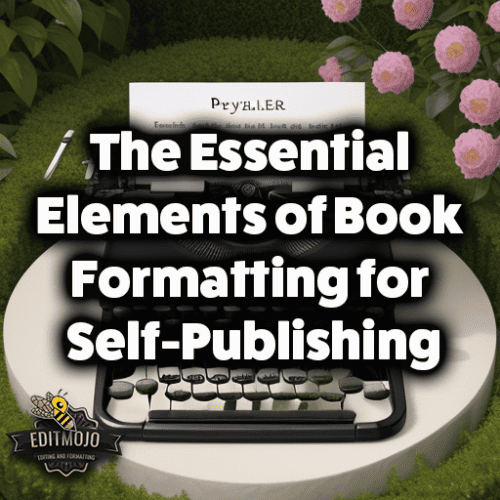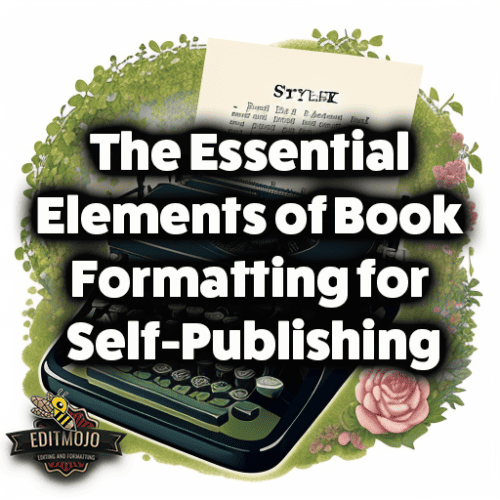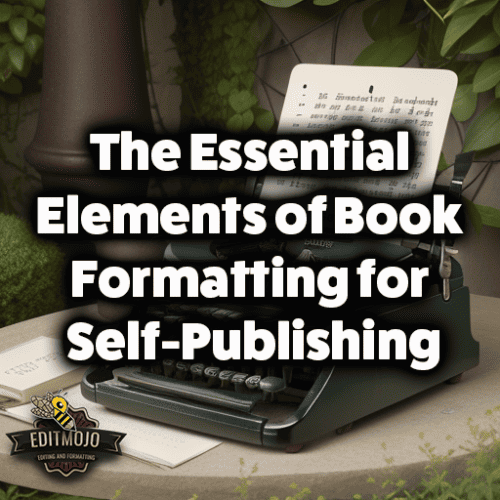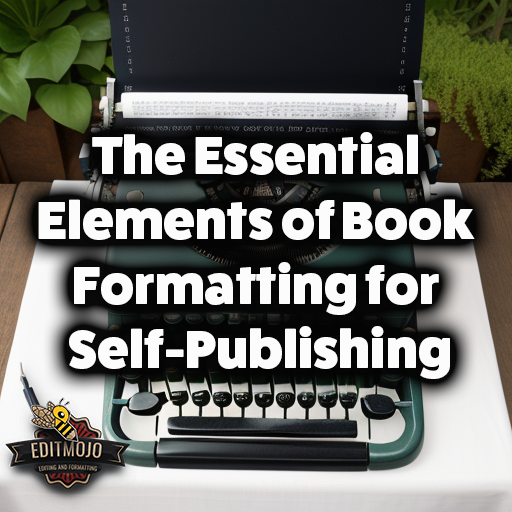The Essential Elements of Book Formatting for Self-Publishing
The Essential Elements of Book Formatting for Self-Publishing. Self-publishing is an incredible journey filled with equal parts of exhilaration and challenge. You own every part of the process, which is empowering yet daunting. Among these myriad steps is a vital one that often gets overlooked: book formatting. Proper book formatting is key to transforming your manuscript into a polished, professional, reader-friendly book. Let’s delve into the essential elements that will make your self-published book stand out.
Key Takeaways Table
| Key Element | Key Takeaway |
|---|---|
| Cover Design | A captivating and professional cover design is essential to attract readers. |
| Interior Layout | A clean and reader-friendly layout impacts the reading experience significantly. |
| Font Selection | A font that is easy to read and reflects your book’s tone enhances readability. |
| Book Size and Format | The book’s size and format contribute to its overall appearance and should fit its purpose. |
| Headers and Footers | Headers and footers provide useful navigation and context to the reader. |
| Page Numbering | Correct page numbering is crucial for a professional-looking book. |
| Front Matter and Back Matter | These sections provide additional context and information to your book. |
| Formatting Tools and Services | Using tools or hiring a professional can save time and ensure a well-formatted book. |
| Formatting Based on Genre | Different genres have specific formatting norms that need to be considered. |
| Common Formatting Mistakes | Attention to detail and proofreading can help avoid common formatting mistakes. |
Understanding the Basics of Book Formatting
What is book formatting? In essence, it is the process of setting your text and images into a predefined, structured layout that can be easily read and understood. It influences how your words appear on a page or a screen, and ultimately, it significantly impacts your readers’ experience. The adage don’t judge a book by its cover might be idealistic, but the reality is people often do. The same goes for your book’s interior layout; if it’s hard to read or looks unprofessional, readers may lose interest, no matter how brilliant your content might be.
There are also two main types of formatting to consider: Ebook and Print. Ebooks require specific formats to ensure they can be read on various devices, while print books need to consider aspects such as margins, headers, footers, and page numbers.

Essential Elements of Book Formatting
Cover Design
A great cover design is the cornerstone of a successful self-published book. It’s your book’s first impression, and it could be the difference between a potential reader picking up your book or passing it by. A captivating cover design should be professional and appealing, with a clear title and author name, and it should give a glimpse into your book’s content.
Take for example the cover of The Fault in Our Stars. It’s simple, but the cloud illustration subtly hints at the theme of the book. Remember, less is often more when it comes to cover design. Steer clear of cluttered designs or tiny texts that are hard to read.
Interior Layout
The interior layout determines how your content appears on each page. It includes margins, line spacing, paragraph indentation, and more. These elements may seem small, but together they make a big difference. Consider books like Infinite Jest by David Foster Wallace; its complex narrative structure with extensive footnotes presents a unique formatting challenge. The way the footnotes and text are laid out, however, greatly improves the reading experience. A well-formatted book is easier to read, and it gives your work a professional finish that readers will appreciate.
Font Selection
The right font can enhance readability and reflect your book’s tone. Think about the Harry Potter series; the distinct font used for the chapter titles perfectly captures the magical theme of the books. Fonts like Times New Roman, Arial, and Calibri are standard for the body text, primarily because they’re easy on the eyes. Your font choice should ultimately serve your content and your readers, rather than distract from it.

Book Size and Format
The size and format of your book also contribute to its overall appearance and the reading experience. For instance, a compact, pocket-sized book is suitable for a novel or self-help book that people might carry around, while a large, hardcover format might be more appropriate for a coffee table book or an illustrated children’s book.
Headers and Footers
Headers and footers provide useful information such as the book’s title, author’s name, and page numbers. They also help guide readers through the book. For example, J.R.R. Tolkien’s The Lord of the Rings uses headers effectively to display the book’s title and the part of the book the reader is in, creating a clear navigational guide.
Page Numbering
Page numbering may seem like a no-brainer, but it’s often done incorrectly. Your main text should have Arabic numerals (1, 2, 3, etc.), starting from the first chapter. The front matter (title page, table of contents, etc.) is typically numbered separately with lowercase Roman numerals (i, ii, iii, etc.).
Front Matter and Back Matter
The front matter and back matter might not directly contribute to your story, but they provide additional information and context. The front matter includes elements like the title page, copyright page, dedication, and table of contents. The back matter may contain an about the author section, acknowledgments, appendices, or an index.
Navigating Book Formatting Tools and Services
There are various tools available, like Kindle Create and Vellum, which simplify the formatting process. However, hiring a professional formatter could save you time and stress, especially for more complex books. Remember, your time also has value, so it might be more economical to outsource this step.
Formatting for Different Book Genres (The Essential Elements of Book Formatting for Self-Publishing)
Different book genres have different formatting norms. Non-fiction books often require a detailed index, while fiction books may benefit from a dedicated section outlining other works by the author. Children’s books, on the other hand, have their unique requirements with more emphasis on illustration and less on text.

Common Book Formatting Mistakes and How to Avoid Them
Common mistakes include inconsistent paragraph indentation, incorrect page numbering, and overlooking widows and orphans (isolated lines at the beginning or end of a page). Attention to detail and careful proofreading can help you catch and fix these issues. Learning from successful self-published authors can also provide valuable insights.
In conclusion, formatting is a crucial step in the self-publishing process. It’s more than just arranging text on a page; it’s about creating a seamless reading experience. A well-formatted book signifies a professional attitude and respect for your readers, which in turn increases your credibility as an author.
As American author John Green once said, “The book you write is not made of words alone. It is also made of sentences and paragraphs, and of chapters.” Don’t forget that a great book is not just about the story but also how the story is presented to the reader.
For more in-depth knowledge, check out the comprehensive guide by Joel Friedlander, a renowned book designer, and explore the self-publishing section of the Writers’ Digest. Happy self-publishing!
Top Five Questions and Answers (The Essential Elements of Book Formatting for Self-Publishing)
| Questions | Answers |
|---|---|
| Why is book formatting important? | Formatting is crucial because it affects readability and the overall reading experience. A well-formatted book appears professional and can help attract and retain readers. |
| What are some common mistakes in book formatting? | Common mistakes include inconsistent paragraph indentation, incorrect page numbering, cluttered cover designs, and overlooking widows and orphans in the text. |
| How should I choose the size and format of my book? | The size and format of your book should fit its purpose and content. For instance, a novel may suit a pocket-sized book, while a coffee table book may require a larger format. |
| Can I format my book myself? | Yes, with various tools available like Kindle Create and Vellum, you can format your book. However, for complex books, hiring a professional may save time and ensure better results. |
| How does genre influence book formatting? | Different genres have specific formatting norms. For instance, non-fiction books often require a detailed index, while fiction books may include a section outlining other works by the author. |
Top Seven Resources and Further Reading (The Essential Elements of Book Formatting for Self-Publishing)
| Resource | Keyword |
|---|---|
| Joel Friedlander’s Comprehensive Guide | Book Design |
| Writers’ Digest Self-publishing Section | Self-publishing |
| The Book Designer – Blog by Joel Friedlander | Book Formatting |
| The Creative Penn | Self-Publishing Tips |
| Kindle Direct Publishing (KDP) Community | Kindle Publishing |
| Reedsy Blog | Publishing Guides |
| Alliance of Independent Authors (ALLi) Blog | Independent Publishing |
